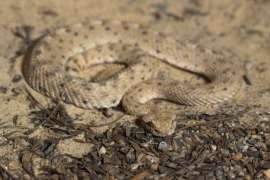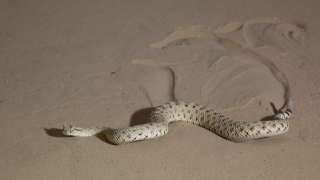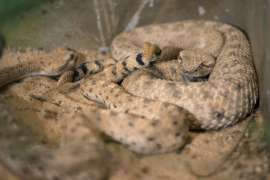Sidewinder
Sidewinder
Sidewinders get their name from their unique form of side-stepping locomotion that is an adaptation for moving across loosely packed desert sands. They are a type of rattlesnake and are venomous.
Crotalus cerastes
Venomous
Carnivore
North America [VIEW MAP]
Deserts
These snakes may be seen in the indoor gallery section of the main building of Scaly Slimy Spectacular. Like most snakes, however, they are relatively sedentary, so only the luckiest guests will get to see them perform their distinctive side-winding locomotion.
Photos and Videos
Sidewinders are a species of rattlesnake. While they are venomous pitvipers, they are shy and mostly nocturnal, resulting in relatively few bites to humans. They feed almost exclusively on rodents and lizards. At night, they roam relatively long distances, smelling the air and substrate for prey. During the day, they use a specialized wiggling motion to bury their bodies in loose sand, always in the shade of a bush to protect from intense daytime temperatures. In this semi-buried coil, with their heads right at the surface, they will lie and wait for prey that approaches too closely. The bite quickly paralyzes and kills the prey. After swallowing prey, the snakes descend into burrows formed by other animals to digest their meals. In addition to their characteristic and well-studied sidewinding behavior, sidewinders are capable of other, more traditional forms of snake locomotion, but only rarely use them. The sidewinding gait aids with movement across shifting sands, as well as other surfaces, including hardpan desert soil and roadways.
Because of their unique form of locomotion, sidewinders are the fastest-moving of all rattlesnakes.
The distinctive black-and-white banding at the base of the rattle is used as a lure. The snakes shuffle their bodies into soft sand, with their heads barely exposed, then twitch the tail to attract prey.
Sidewinders have raised scales atop their eyes. The function of these remains unknown.
Like many other species of pitviper, females of this species will stay with their young for a period of time after they are born. The babies are live-born rather than hatching from eggs. After they shed their skin for the first time, they disperse into the world on their own.
Despite being extremely hot in the summer, the southwestern deserts of the U.S. are cool in winter, so sidewinders hibernate during this period, usually in abandoned rodent burrows.
The sidewinder’s lifespan is 20 years or more.
These snakes may be seen in the indoor gallery section of the main building of Scaly Slimy Spectacular. Like most snakes, however, they are relatively sedentary, so only the luckiest guests will get to see them perform their distinctive side-winding locomotion.
This species occurs in two of the four major North American deserts: the Mohave Desert and the Sonoran Desert.
This species lives mostly in very sandy areas of the deserts of the southwestern U.S. and adjacent Mexico, where their unique sidewinding locomotion is an excellent adaptation. Sidewinders occasionally show up in suburban areas of places like Palm Springs, California, or Phoenix, Arizona, where human development has encroached into their native desert habitats.
In the wild, sidewinders eat almost exclusively rodents and lizards, with kangaroo rats, whiptail lizards, and fringe-toed lizards being favorite prey. At the Zoo, they do fine on a steady diet of mice.
In collaboration with physicists and engineers from Georgia Tech and Carnegie Mellon University, Zoo Atlanta staff are studying sidewinding locomotion in order to refine the abilities of snake-shaped robots to traverse loose sand environments without getting stuck. This research has important potential applications for search-and-rescue, military, lunar-lander types of operations, and even archeological exploration. So far, the research has been very successful, and we now have operating prototype robots that can be programmed to face the challenges of a variety of different sandy environments and obstacles.
While moving, sidewinders have to specifically detect fine differences in the shifting sand substrate underneath them, including the slope of the dune. Sands, technically known as “granular media,” are unusual because they possess a mixture of qualities of both a solid and a liquid. Anyone who has jogged on a beach can attest to the physical difficulty and challenges of locomotion across such a peculiar and unpredictable substrate. Now, our robots are very much more capable in such environments. The robots also allowed us to better understand how exactly non-sidewinding species of snakes fail on sand.
More on Zoo Atlanta’s Research [link]



